| dc.contributor.author | Mbugua, Dorcas W | |
| dc.date.accessioned | 2016-11-18T07:35:08Z | |
| dc.date.available | 2016-11-18T07:35:08Z | |
| dc.date.issued | 2016-10 | |
| dc.identifier.uri | http://hdl.handle.net/11295/97534 | |
| dc.description.abstract | This study examined the relationship between capital structure and the financial performance of deposit taking micro finance institutions (DTMFIs) in Kenya. The Microfinance Act of 2006 operationalized microfinance institutions which were purely focusing on micro lending activities to apply for licenses from Central Bank of Kenya to allow them to take deposits from customers. Today these micro banking businesses that receive saving deposits are known as Deposit taking microfinance institutions. According to Jensen (1986), the formation of a financial structure can control the structure of a firm which might control the capability of a firm to formulate planned choices. This study sought to investigate the relationship between capital structure and financial performance of Deposit taking microfinance institutions in Kenya. The study used a descriptive design to describe the characteristics of the six DTMFIS in Kenya as at 31st December 2015 and the study covered a three year period from 2013-2015. Secondary data was collected from the CBK and Association of Microfinance institutions of Kenya (AMFI) and the annual reports from the Deposit taking microfinance institutions. Capital structure was measured as total long term debt to equity ratio whereas financial performance was measured using return on assets (ROA) which is Net profits after taxes/Average assets. In addition, two controlled variables were used; Long term debt / Total Assets, Shareholders fund/Total Assets. Data was then analyzed using a regression analysis model with the help of statistical software Statistical Package (SPSS). The study used Multiple regression analysis determine the relationship between the variables under study. The data findings were presented using tables to show the relationships. The findings indicated that Capital structure (total long term debt to equity ratio) positively affects the financial performance of the Deposit taking microfinance institutions. .Long term debt to assets also has a positive impact on ROA, but the relationship was not significant. Shareholders‟ fund to total assets also has a positive impact on financial performance. This study concludes by drawing some policy propositions geared towards capital structure to enhance financial performance of the DTMFIS.From the findings, the study recommends that strategies to ensure a financial structure that is suitable for achieving a good financial health and performance should be adopted by DTMFIS and the entire finance sector institutions as a whole. | en_US |
| dc.language.iso | en | en_US |
| dc.publisher | University of Nairobi | en_US |
| dc.rights | Attribution-NonCommercial-NoDerivs 3.0 United States | * |
| dc.rights.uri | http://creativecommons.org/licenses/by-nc-nd/3.0/us/ | * |
| dc.title | The Relationship Between Capital Structure and the Financial Performance of Deposit Taking Microfinance Institutions in Kenya | en_US |
| dc.type | Thesis | en_US |



